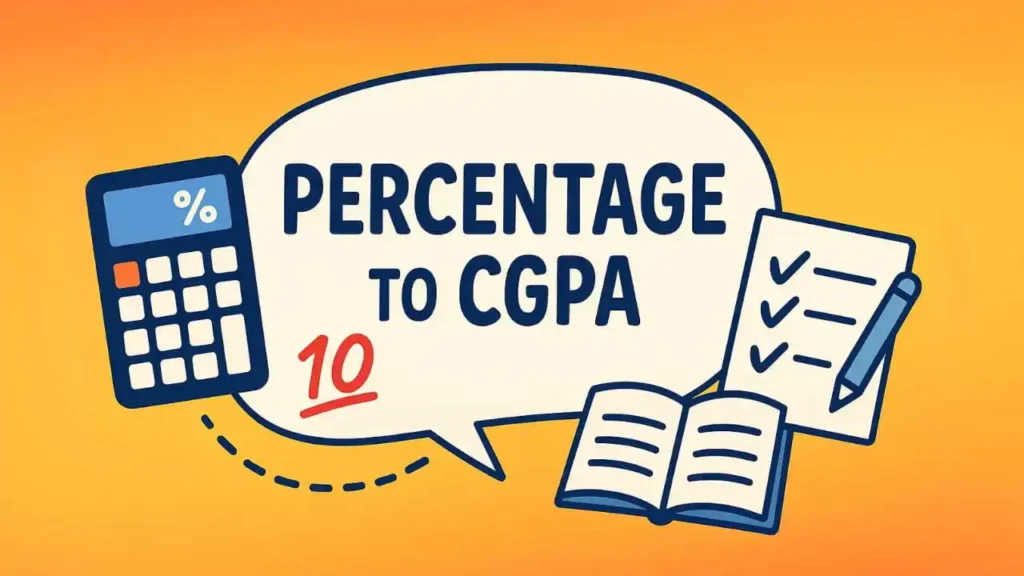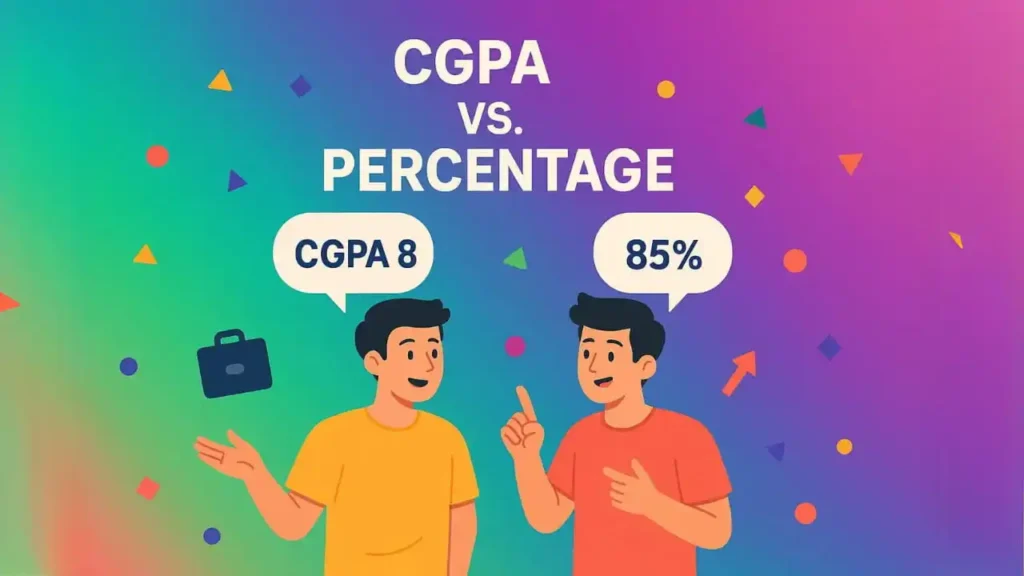Percentage to CGPA Calculator
Percentage to CGPA Calculator: Quick and Accurate
Confused by academic grading systems? Our Percentage to CGPA Calculator transforms your percentage marks into precise CGPA format instantly. Need to convert in the opposite direction? Try our CGPA to Percentage converter as well. Whether you’re applying to Delhi University, preparing for international admissions, or comparing scores across institutions, these free tools eliminate conversion complexity. Simply enter your values and get results tailored to your academic needs.

The CGPA system has become widespread across Indian universities for good reason. Unlike simple percentage marks, CGPA simplifies how schools rate student academic work. This approach puts your achievements on fixed scales, usually out of 10 points at most Indian colleges. But there’s more to know about how different universities use these numbers.
Percentage to CGPA Calculator: What It Is and How to Use It?
How to Use Our Percentage to CGPA Calculator? A Step by Step Guide
Why CGPA Conversion Matters?
How to Convert Percentage to CGPA?
Conversion Table – Percentage Into CGPA

| Percentage | CGPA (Approx) |
|---|---|
| 95 percent | 10.000 |
| 92 percent | 9.684 |
| 90 percent | 9.474 |
| 89 percent | 9.111 |
| 88 percent | 9.011 |
| 87 percent | 9.158 |
| 86 percent | 8.811 |
| 85 percent | 8.947 |
| 83 percent | 8.737 |
| 80 percent | 8.421 |
| 79 percent | 8.111 |
| 77 percent | 8.105 |
| 75 percent | 7.895 |
| 72 percent | 7.579 |
| 70 percent | 7.368 |
| 69 percent | 7.111 |
| 68 percent | 7.011 |
| 67 percent | 7.053 |
| 65 percent | 6.842 |
| 63 percent | 6.511 |
| 62 percent | 6.526 |
| 60 percent | 6.316 |
| 58 percent | 6.011 |
| 57 percent | 6.000 |
| 55 percent | 5.789 |
| 52 percent | 5.474 |
| 50 percent | 5.263 |
| 47 percent | 4.947 |
| 45 percent | 4.737 |
| 42 percent | 4.421 |
| 40 percent | 4.211 |
Understanding Grading Systems
Percentage-based Grading System
CGPA-based System
Point-based Grading System
Why Do Different Institutions Use Different Grading Systems?
During the years analyzing educational boards across India, I’ve seen clear reasons why schools and colleges use different grading methods. These differences show what each school values most in education.
Historical Evolution and Institutional Identity
Regional Educational Priorities
International Alignment and Globalization
Comparing the Percentage Scoring System with the CGPA: A Comprehensive Analysis
- Basis of Assessment: While percentages represent direct scores received in exams and assignments as raw numbers, the CGPA system calculates an average grade point that reflects your overall achievement across multiple topics and semesters. When this transition was implemented at a prominent Delhi college, students immediately noticed how the CGPA smoothed out performance variations between different subjects.
- Granularity and Perspective: The percentage system provides a more detailed picture of a student’s performance in individual subjects, showing exact numerical differences between achievement levels. In contrast, the CGPA offers a combined perspective that I’ve found particularly helpful when advising students on graduate applications, as it presents a broad picture of academic consistency rather than isolating single exam results.
- Scale and Standardization: Percentages are universally calculated out of 100, making them immediately comprehensible across institutions. Meanwhile, CGPAs typically follow either a 4-point scale (common in international institutions) or a 1-10 scale (prevalent in Indian universities). During my research on Mumbai University’s grading committee, we found the 10-point scale provided better differentiation between performance levels.
- Interpretation and Application: The percentage system facilitates thorough subject-by-subject analysis that highlights specific strengths and weaknesses. The CGPA system delivers a comprehensive assessment that balances variations across subjects and examination patterns.
- Real-world Significance: Beyond academics, these measurement systems have different impacts on career prospects. Many multinational companies I’ve researched, prefer the CGPA system for its standardization, while certain government positions in India still require percentage cutoffs. Understanding how to translate between these systems remains essential for presenting your academic credentials effectively.
To see exactly how your percentage maps to a 10, 5, or 4-point CGPA, try our Percentage to CGPA converter supporting all three scales.
Institution-Specific Percentage to CGPA Conversion Methods: Master Your Grade Transformation

1) Delhi University (DU) Conversion Method
2) Mumbai University Conversion Method
3) VTU University Conversion Method
VTU University employs a more complex system using the formula CGPA = ∑(Ci x Si) / ∑ Ci, where Si represents the SGPA of the ith semester and Ci represents the total number of credits obtained in that semester. Through years of helping engineering students navigate this system, I’ve found this method accounts for varying course difficulties by weighting each course based on credit value rather than treating all courses equally.
4) GTU University CGPA Calculation
5) IIT and NIT Grading Systems
The standard 10-point system used by many other engineering colleges follows a straightforward: CGPA = Percentage ÷ 10. This creates the most direct correlation between the two measurement systems.
These institutional differences may seem minor, but I’ve witnessed their significant impact when counseling students applying for further studies or scholarships. A student with 85% could have a CGPA ranging from 8.5 to 9.0 depending on which institution’s conversion method is applied—often determining whether they meet cutoffs for prestigious programs or financial aid opportunities. Always verify your specific institution’s approved conversion method before making important academic decisions.
Common Percentage to CGPA Conversion Mistakes
Using Universal Formulas for Institution-Specific Systems
Neglecting Grade Boundaries and Thresholds
Confusing Scale Systems (10-Point vs. 4-Point)
Another frequent error occurs when students confuse different CGPA scale systems. Indian universities predominantly use 10-point scales while international institutions favor 4-point systems. This confusion creates particular challenges for students applying abroad. Students with graduate applications to American universities, I regularly find they’ve simply divided their 10-point CGPA by 2.5, producing inaccurate conversions that don’t reflect proper equivalence. The correct approach involves understanding the grade distribution philosophy behind each system.
Ignoring Relative Grading Considerations
Many premier institutions like IITs implement relative grading where your CGPA depends not just on absolute performance but on how you perform compared to peers. Students frequently make the mistake of applying absolute conversion formulas to these relative systems. I also noted that many students failed to account for the curve-adjustment factor that modifies standard conversion formulas, often resulting in understated academic performance when applying for international scholarships.
Career Impact of CGPA vs. Percentage
The final common mistake involves incorrectly averaging subject-specific CGPAs rather than converting the overall percentage directly. This overlooks how different subjects might carry different credit weights in your academic program. I’ve consistently found that students who convert each subject’s percentage to CGPA separately before averaging often produce results that deviate from official transcripts by up to 0.3 points – enough to miss crucial cutoffs for competitive programs.

Corporate Recruitment Preferences
Multinational corporations typically prefer CGPA systems for their initial screening process. I’ve seen how they value CGPA for its standardization across institutions. A student with 8.5 CGPA from a tier-2 college often advances further in selection processes than one with 75% from the same institution. This happens because recruiters perceive CGPA as reflecting consistent performance rather than examination-specific preparation. Tech giants like Google and Microsoft explicitly state minimum CGPA requirements (typically 7.5/10) rather than percentages in their campus recruitment criteria.
Government and Public Sector Considerations
Government jobs in India still overwhelmingly use percentage thresholds in their eligibility criteria. Studying UPSC aspirants, I found that nearly all government postings specify minimum percentage requirements rather than CGPA equivalents. For instance, banking sector positions typically require 60% aggregate marks, while engineering services demand 65% without mentioning CGPA alternatives. This creates a conversion necessity for students from universities using CGPA-only transcripts who must accurately translate their scores when applying for these positions.
Higher Education and Research Opportunities
For graduate admissions, academic institutions increasingly favor CGPA systems—especially for international applications. I’ve noted that institutions like MIT and Stanford explicitly request CGPA or GPA rather than percentages. Indian institutions are following suit, with IIMs and other premier management institutes now preferring CGPA for their screening process. This shift reflects a global trend toward standardized academic measurement that better accommodates diverse educational backgrounds.
Industry-Specific Variations
Different sectors prioritize these metrics differently. Technical industries emphasize CGPA as an indicator of consistent learning ability, while creative fields often disregard both metrics in favor of portfolio assessments. Financial services companies generally consider both metrics alongside aptitude tests, creating a more balanced evaluation framework. Understanding these nuances allows students to strategically present their academic performance according to their target industry’s preferences.
Practical Applications of Percentage to CGPA Conversion
Having guided countless students through academic transitions, I’ve seen three critical scenarios where converting percentage to CGPA makes all the difference:
- Academic Transcripts: When applying to foreign universities, your percentage-based system scores need proper translation. An 85% in India needs accurate conversion for institutions overseas to understand your true standard.
- Applications for Jobs: Global corporations use CGPA for consistent evaluation of applicants. Employers worldwide recognize CGPA as the universal norm, making conversion essential for career advancement.
- Admissions Abroad: International program admissions require estimated CGPA over raw percentage scores. When students apply to institutions in other nations, converted scores communicate your overall academic ability clearly.
Global Academic Measurement Systems: Converting Between International Grading Standards
During my academic journey, I’ve seen how critical accurate conversions become especially for international opportunities.
Converting Indian CGPA to US GPA
The standard conversion formula follows: US GPA = (Indian CGPA × 0.4). This means your 9.5 CGPA from Delhi University translates to a 3.8 GPA in America. Most US institutions recognize this calculation method, though prestigious universities like Harvard and Stanford may apply additional evaluation criteria beyond the raw conversion.
10-point CGPA to 4-point GPA Conversion
The standard formula is: US GPA = (Indian 10-point CGPA × 0.4). For example, an 8.5 CGPA converts to a 3.4 GPA on the US scale. This applies to most Indian universities, but elite institutions require adjustments—IITs often use (CGPA × 0.35) while NITs typically follow the standard formula. Always verify if your target foreign university has India-specific conversion protocols published on their admissions website.
UK, Australia, and Canada Equivalents
Each country employs distinct systems: UK uses honors classifications (First Class = 8.5+ CGPA), Australia uses percentage equivalents (Distinction = 7.5-8.4 CGPA), while Canada follows the US 4.0 scale with provincial variations. Canadian universities typically require precise documentation showing your institution’s official conversion methodology rather than applying generic formulas.
Latest Updates in Indian Grading Systems
The National Education Policy 2020 represents the most significant transformation in India’s grading landscape in decades, shifting from rigid percentage-based evaluations to a flexible credit-based system that emphasizes holistic assessment. This reform introduces formative evaluation methods across educational institutions, replacing traditional year-end examinations with continuous performance tracking through a semester-based structure that better reflects student capabilities and reduces examination pressure.
Universities are implementing these NEP directives at varying paces, with institutions like Delhi University and Anna University already adopting outcome-based education frameworks that assign credits based on learning outcomes rather than teaching hours. The Academic Bank of Credits system further revolutionizes grading by allowing students to accumulate credits across different institutions throughout their academic journey, creating unprecedented educational flexibility while maintaining standardized evaluation criteria—a critical development for students needing accurate percentage-to-CGPA conversions for career mobility across institutions.
Conclusion
Converting percentage scores to CGPA has become essential for Indian students navigating today’s complex educational landscape. As we’ve explored, each institution implements unique conversion formulas—from Delhi University’s straightforward calculation to IIT’s specialized approaches. Understanding these differences ensures you present your academic achievements accurately across different contexts. Our Percentage to CGPA Calculator eliminates conversion confusion by providing instant, accurate results for all major Indian grading systems. Whether you’re applying for higher education abroad, preparing job applications, or simply understanding your academic standing, proper conversion creates opportunities that might otherwise be missed.
The shift toward CGPA-based assessment under NEP 2020 further emphasizes the importance of mastering these conversions. With educational institutions increasingly adopting standardized credit systems, your ability to translate between percentage and CGPA becomes even more valuable. For immediate, accurate conversions tailored to your specific institution, try our free Percentage to CGPA Calculator tool. Simply enter your percentage, select your institution’s scale, and receive precise CGPA results instantly—no more conversion confusion or missed opportunities due to incorrect grade presentation.
FAQs
The general formula is CGPA = Percentage ÷ 9.5 for the 10.0 scale. For 4.0 scale, divide your percentage by 25, and for 5.0 scale, divide by 20. Different universities may use slightly different formulas, but these calculations work for most Indian institutions. Our converter tool lets you select your scale (4.0, 5.0, or 10.0) and instantly calculates your CGPA without complex math.
On the 10.0 scale used by most Indian universities, the maximum CGPA is 10.0, representing excellent academic performance (95-100%). For the 4.0 scale, the maximum is 4.0 (equivalent to 90-100%), while the 5.0 scale caps at 5.0 CGPA. Achieving above 9.0 on the 10.0 scale is considered outstanding at most institutions.
Most engineering colleges in India use the 10.0 scale with the formula CGPA = Percentage ÷ 9.5. Some technical universities may use credit-weighted calculations, but our converter simplifies this process. Just select the 10.0 scale option in our tool, enter your percentage, and get your engineering CGPA instantly without complex calculations.
No, conversion methods vary between Indian institutions. While most use the standard formulas (divide by 9.5 for 10.0 scale, by 20 for 5.0 scale, and by 25 for 4.0 scale), some universities have unique calculations. Our converter uses the most widely accepted formulas for each scale, ensuring accurate results for most educational institutions.
For international applications, convert your 10.0 scale CGPA to the US 4.0 GPA using: US GPA = Indian CGPA × 0.4. For example, an 8.5 CGPA converts to a 3.4 GPA. Our converter helps with the first step by accurately calculating your CGPA on your chosen scale before applying for international opportunities.
On the 10.0 scale, a CGPA above 8.0 is considered excellent (75%+). A CGPA between 7.0-8.0 is very good (65-75%), while 6.0-7.0 is good (55-65%). For the 4.0 scale, above 3.2 is excellent. Standards vary slightly by field of study—technical programs typically have higher benchmarks than humanities courses.
Yes, our converter is perfect for job applications where employers specify CGPA requirements. Many corporations in India now state minimum CGPA thresholds rather than percentages. Government positions still predominantly use percentage criteria, making accurate conversion essential when preparing your applications. Our tool helps present your qualifications correctly.
Our calculator offers three standard scales: 10.0 (most common in India), 5.0 (used by some technical institutions), and 4.0 (international standard). Simply select your required scale, enter your percentage, and get instant, accurate results. The tool automatically applies the appropriate formula for each scale: dividing by 9.5 for 10.0 scale, by 20 for 5.0 scale, and by 25 for 4.0 scale.
